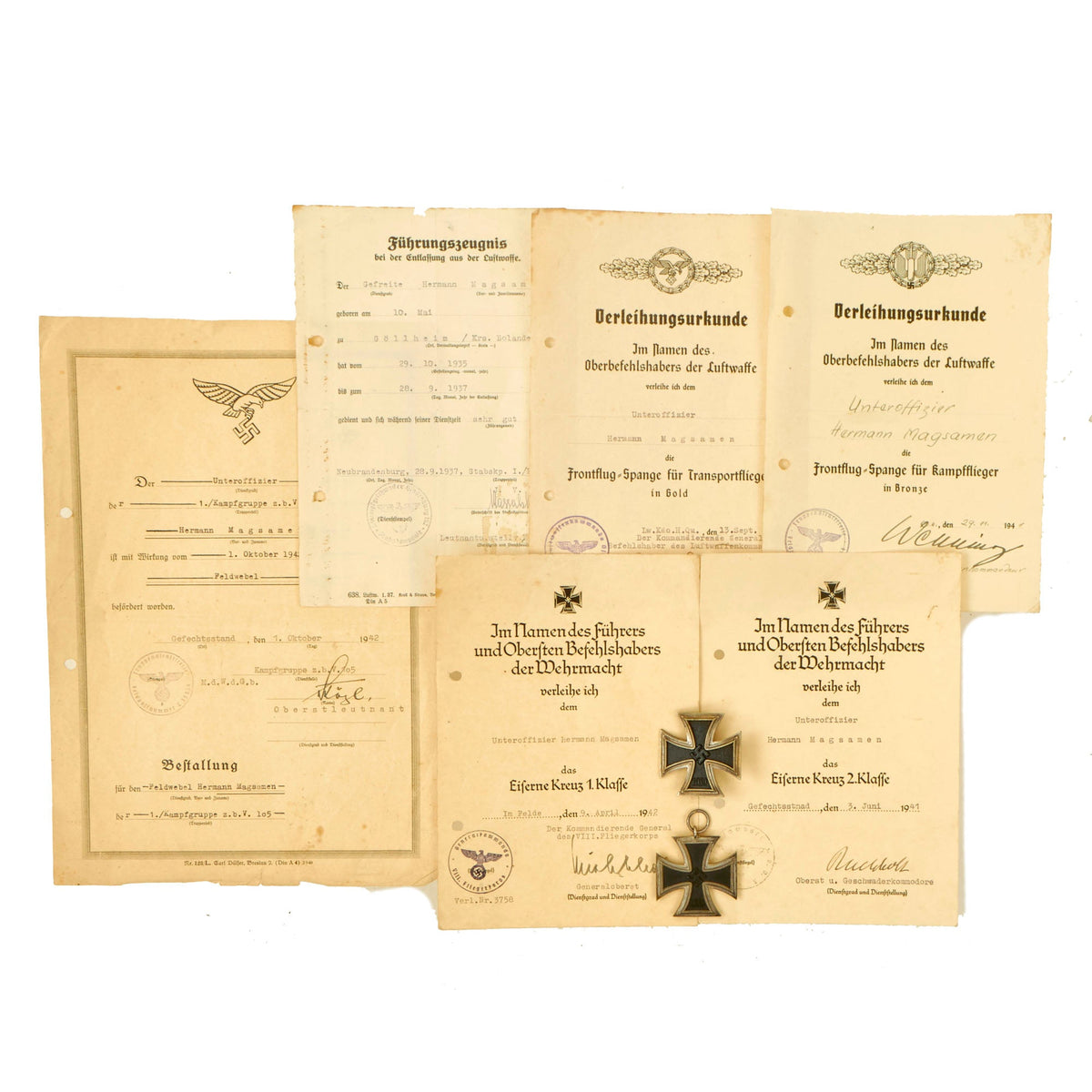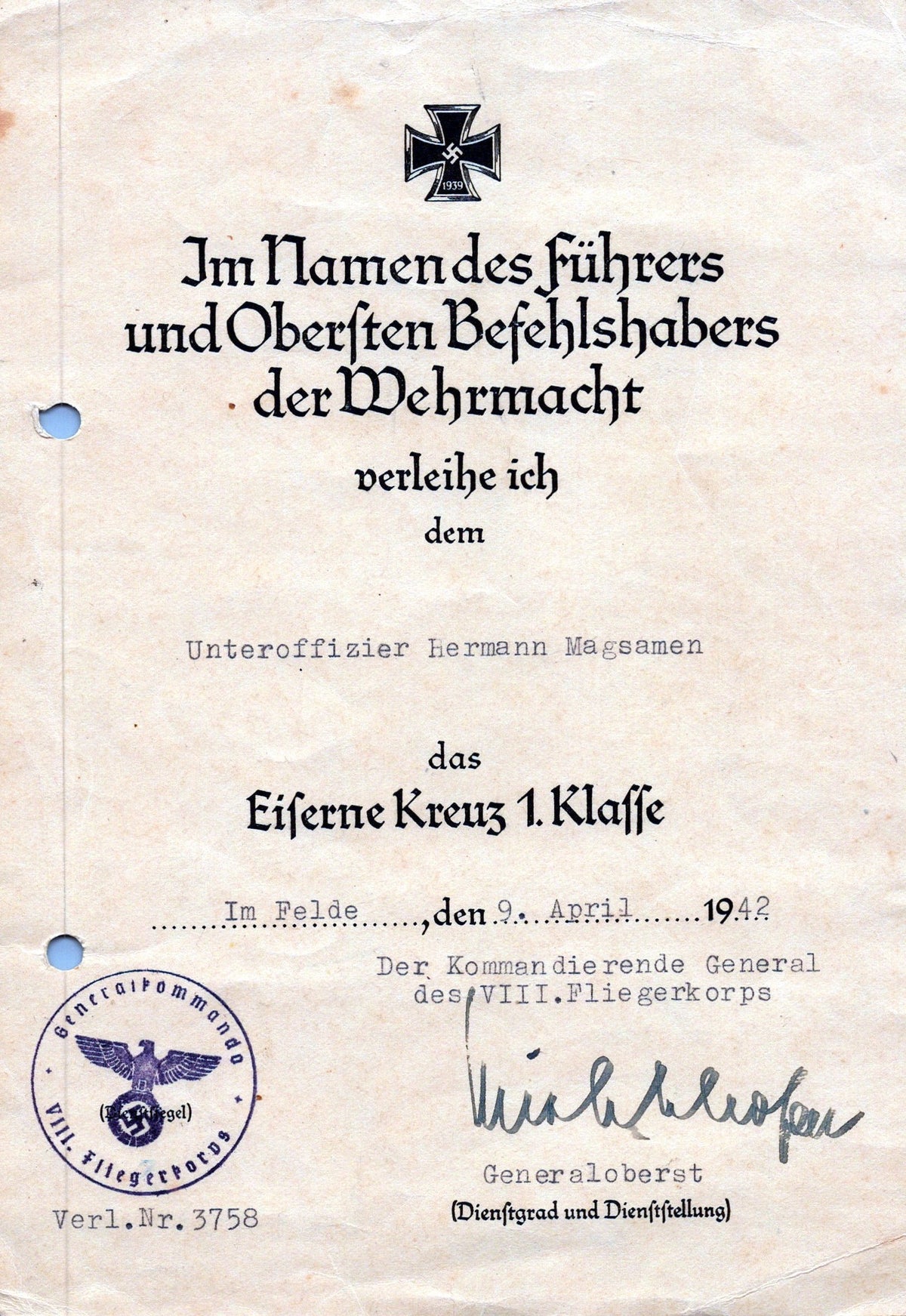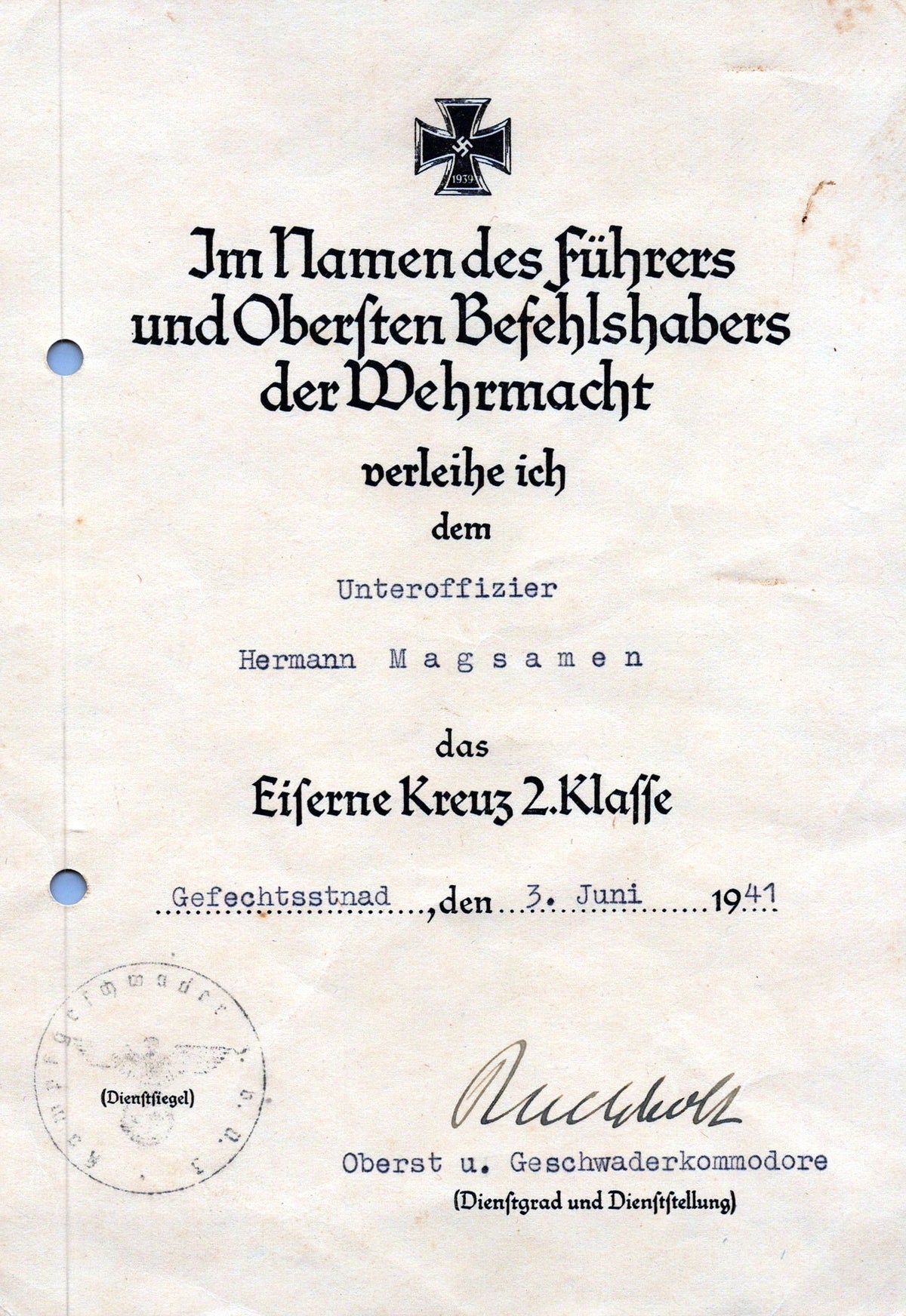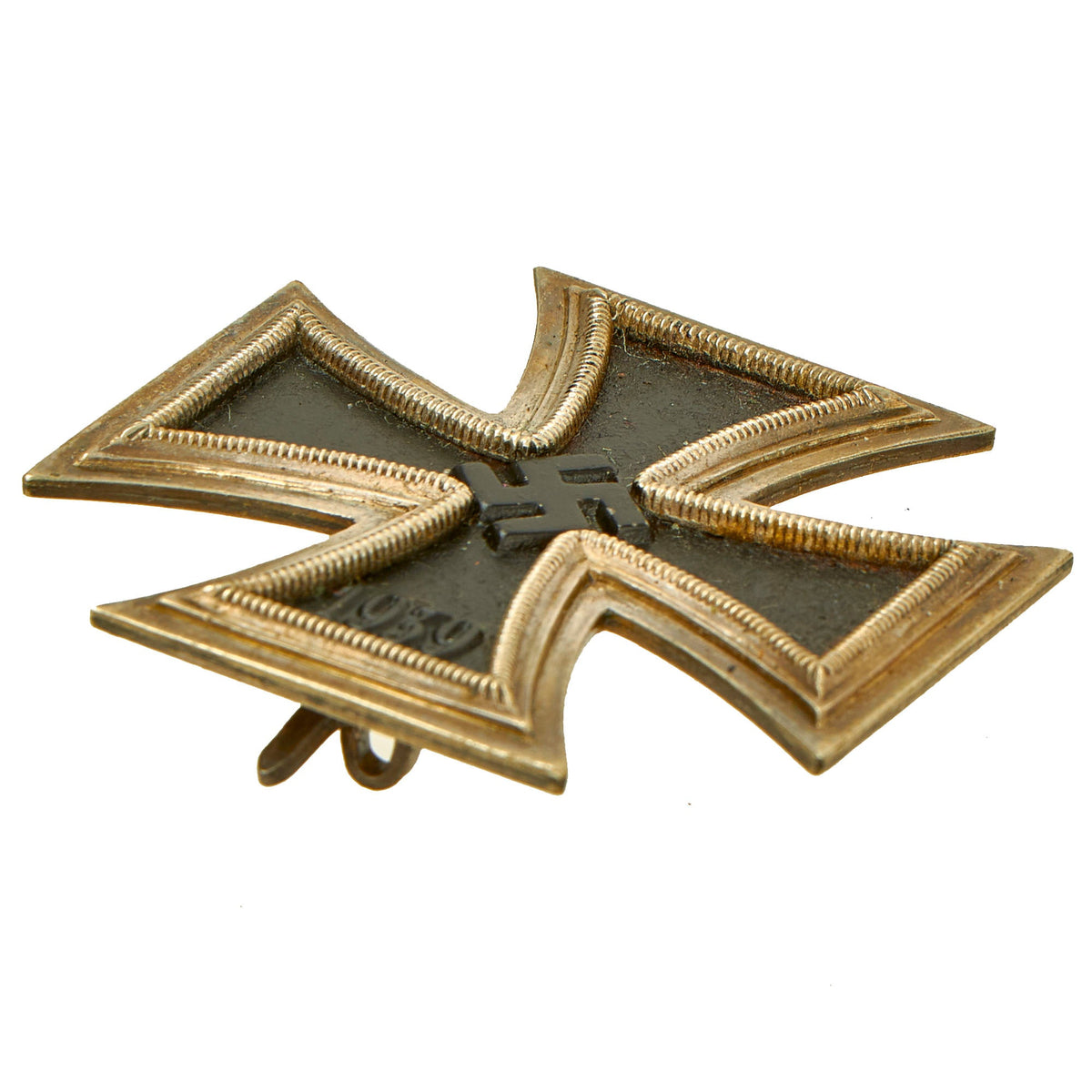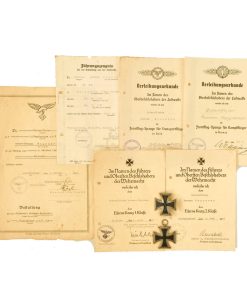Original German WWII Luftwaffe Feldwebel Hermann Magsamen Award and Document Grouping – EKII, EKI & More Original Items
$ 495,00 $ 148,50
Original Items: One-of-a-kind grouping. This is a fantastic named Heer award and document set, with two original German WWII awards, each with their original BESITTZZEUGNIS “possession/award” certificates. There are also other award certificates for items not included in the set, as well as some additional documents as well. All are named to the same soldier, Hermann Magsamen, who was born 10. Mai 1914. He is first mentioned in 1937 as being a Gefreite (exempted), an enlisted rank equivalent to a U.S. Airforce “Airman”, while by the end of 1942 he is listed as being a Feldwebel, an NCO rank equivalent to a U.S. Airforce Technical Sergeant. The documents show his progression from enlisted up to a mid-level NCO during the war, having received awards along the way! It’s very rare that we get such a large document set showing the history of a soldier!
The first document we have is a Führungszeugnis bei der Entlassung aus der Luftwaffe (Certificate of good conduct upon discharge from the Air Force), which indicates that Gefreite Hermann Magsamen served from 29. 10. 1935 to 28. 9. 1937 in the Luftwaffe. It further indicates that Magsamen gedient und sich seiner Dienstzeit sehr gut gefürhrt (served and conducted his period of service very well). So it would appear that he enlisted and completed his first term of service during the pre-war mid 1930s.
Magsamen then must have joined back up, and by 1941 had been promoted to Unteroffizier, a Junior NCO rank equivalent to a U.S. Airforce Sergeant. He was involved in combat as flight crew, and on 3. Juni 1941. he was awarded the Eisernes Kreuz II. Klasse (Iron Cross 2nd Class 1939 – EK II), as indicated by the second document in the set. This was signed by an Oberst u. Geschwaderkommodore (Colonel and Squadron Commander). He was at that point crew on a Luftwaffe bomber, and he was later awarded the Frontflug=Spange für Kampfflieger in Bronze on 29. 11. 1941, for 20 flown missions.
Magsamen continued to acquit himself well, and was awarded the Eisernes Kreuz I. Klasse (Iron Cross 1st Class 1939 – EK I) on 9. April 1942. This was awarded Im Felde (In the field), and is signed by Der Kommandierende General des VIII. Fliegerkorps (The Commanding General of VIII Air Corps), signed Generaloberst Richthofen. Research indicates this was Generaloberst and later Generalfeldmarschall Wolfram von Richthofen. A noted commander during WWII, he was also the cousin of WWI flying aces Lothar and Manfred von Richthofen, the latter of which is better known as the “Ace of Aces” of WWI, The Red Baron. Manfred encouraged Wolfram to join the Imperial Air Service, and he was assigned to Manfred’s Jagdgeschwader 1 “Flying Circus”. Unfortunately Wolfram’s first mission with the unit on 21 April 1918 was to be Manfred’s last, as he was shot down, ending his reign in the skies. Wolfram went on to claim 8 victories before the end of the war, which technically made him an “Ace” as well.
Magsamen looks to have changed roles in the Luftwaffe at some point in 1942, as the last award document in the grouping is for the Frontflug=Spange für Transportflieger in Gold, awarded on 13. Sept. 1942. For this he had to have flown 110 missions as a transport flyer, definitely an achievement that was not easy to achieve. His commanders felt so as well, as the last document in the grouping indicates that as of 1. Oktober 1942, Magseman was promoted to Feldwebel. This document also indicates that he was part of 1. / Kampfgruppe z.b.V 105, most likely one of the supply units that operated behind the lines. Definitely some great research potential here!
The two awards earned by Gräf which are included with this set (in date order) are the Eisernes Kreuz II. Klasse 1939 (Iron Cross 2nd Class 1939 – EK II), and the Eisernes Kreuz I. Klasse 1939 (Iron Cross 1st Class 1939 – EK I). Both of the awards are in very good condition, though the EKII does not have the original ribbon. They have a lovely patina, with the paint on the central cross well-retained for the most part. The EKI does show some oxidation on the central cross where the paint has bubbled up. The only maker marked award is the EKII, which has 122 marked on the ring, the Präsidialkanzlei des Führers Lieferant (Presidential Chancellery Supplier) number for rare maker J.J. Stahl of Strassburg.
All of the documents are dated, with their correct stamps and signatures. All have typed in particulars except for one that is handwritten. They are in good condition, with the expected wear and yellowing from age, with most showing creases from folding. They vary in size somewhat, with most documents being the smaller 5 1/2″ x 8″ size, and one the larger 8″ x 11 1/2″ size. Please consult the pictures for condition specifics.
A really nice German WWII award set, complete with the original documents named to the same soldier. A great bit of history, showing a good record of Hermann Magsamen’s service and rank history during the pre-WWII period and over the years of the war. A fantastic research opportunity, as well as a great display piece!
There is no more iconic German military award than the Iron Cross. The long history of this order began during the Napoleonic Wars. King Friedrich Wilhelm III of Prussia instituted the “Eisernes Kreuz” (Iron Cross) in March of 1813. The award criteria changed somewhat with time, but generally speaking, Iron Crosses could be awarded for individual acts of bravery, or for leadership achievements on the battlefield. The design was created by a Karl Friedrich Schinkel, his choice of the black cross with silver outline was derived from the heraldic emblem of the Teutonic Knights. This central Tatzenkreuz (cross pattée) struck from iron and mounted in a silver frame which has a raised crenulated decorative border.
There were a number of different type and grades of Iron Cross awards throughout its long history, but the basic details of the most widely awarded grades: The Iron Cross 1st Class and Iron Cross 2nd Class- remained the same. The first class award was a breast badge, with fittings on the reverse to allow it to be worn on the uniform. These fittings varied widely over time and from maker to maker, and could be a simple in and catch, a screw post and retaining disc, or more elaborate setups. The second class award was suspended from a ribbon, originally in the Prussian colors of black and white, later in the Reich colors of black, red and white.
On the original versions of these crosses, in 1813, the front of the iron core of each grade was bare, and only the second class award had ornamentation: a crown over the initials “FW” representing the King, a sprig of oak leaves, and the date 1813. The core was redesigned in 1870, when the cross was re-instituted during the Franco-Prussian War. The reverse ornamentation on the Iron Cross 2nd Class remained the same, but the front of the core on both grades now bore another crown, a “W” representing Kaiser Wilhelm, and the date 1870. This pattern repeated again when the cross was reinstituted for WWI- everything stayed the same, only the date 1870 was replaced with 1914.
The final reinstitution of the cross came in 1939. For this version, the front of the core for both grades bore a swas and the date 1939. The oak leaves, crown and royal initials were removed from the reverse, with only the date 1813 remaining as a reminder of the legacy of this award. In WWII, hundreds of thousands of Iron Cross First Class awards were bestowed, and four and a half million Iron Cross Second Class awards. Iron Crosses were made by a large number of authorized manufacturers. Some variants of these awards were mass produced in huge numbers. Others were made in very limited quantities.
Fast Shipping with Professional Packaging
Thanks to our longstanding association with UPS FedEx DHL, and other major international carriers, we are able to provide a range of shipping options. Our warehouse staff is expertly trained and will wrap your products according to our exact and precise specifications. Prior to shipping, your goods will be thoroughly examined and securely secured. We ship to thousands clients each day across multiple countries. This shows how we're dedicated to be the largest retailer on the internet. Warehouses and distribution centres can be located throughout Europe as well as the USA.
Note: Orders with more than one item will be assigned a processing date depending on the item.
Before shipping before shipping, we'll conduct a thorough inspection of the items you have ordered. Today, the majority of orders will be delivered within 48 hours. The delivery time will be between 3-7 days.
Returns
The stock is dynamic and we cannot completely manage it because multiple stakeholders are involved, including our factory and warehouse. So the actual stock may alter at any time. It's possible that you may not receive your order once the order has been made.
Our policy is valid for a period of 30 days. If you don't receive the product within 30 days, we are not able to issue a refund or an exchange.
You can only return an item if it is unused and in the same state as the day you received it. You must have the item in its original packaging.
Related products
Uncategorized
Uncategorized
Uncategorized
Uncategorized
Uncategorized
Uncategorized
Uncategorized
Uncategorized
Band of Brothers ORIGINAL GERMAN WWII Le. F.H. 18 10.5cm ARTILLERY PIECE Original Items
Uncategorized
Uncategorized
Uncategorized
Uncategorized
Uncategorized
